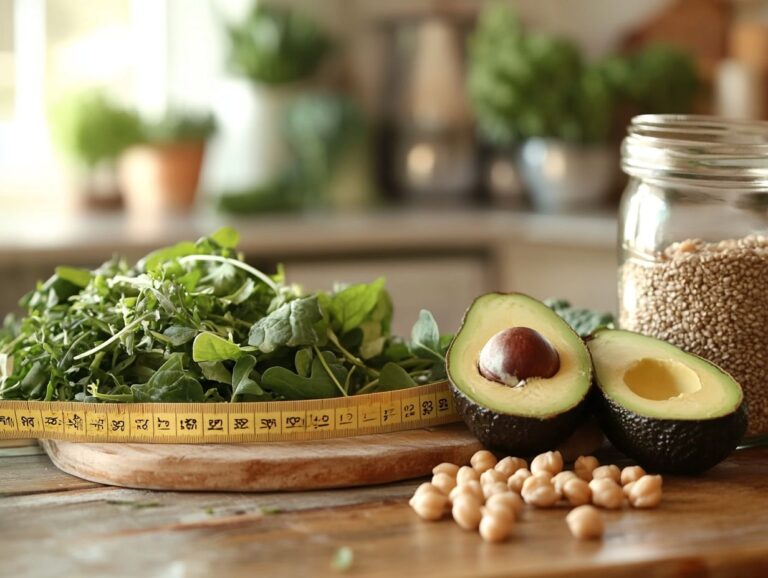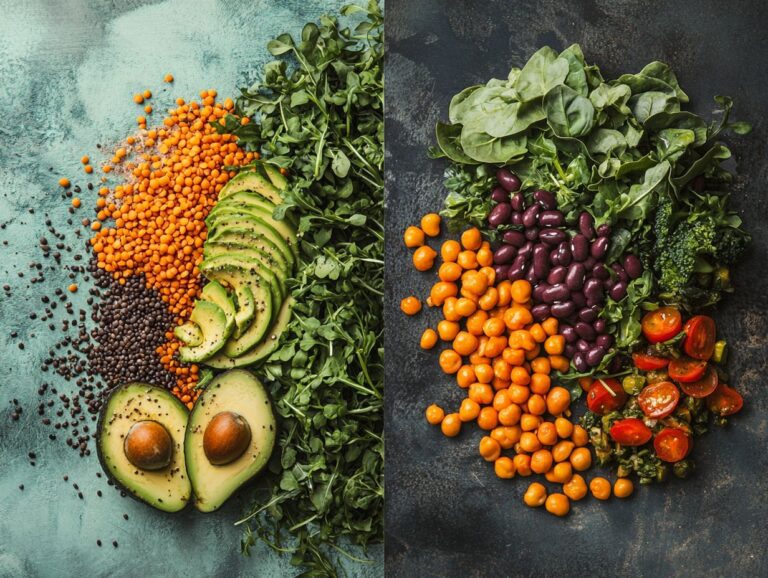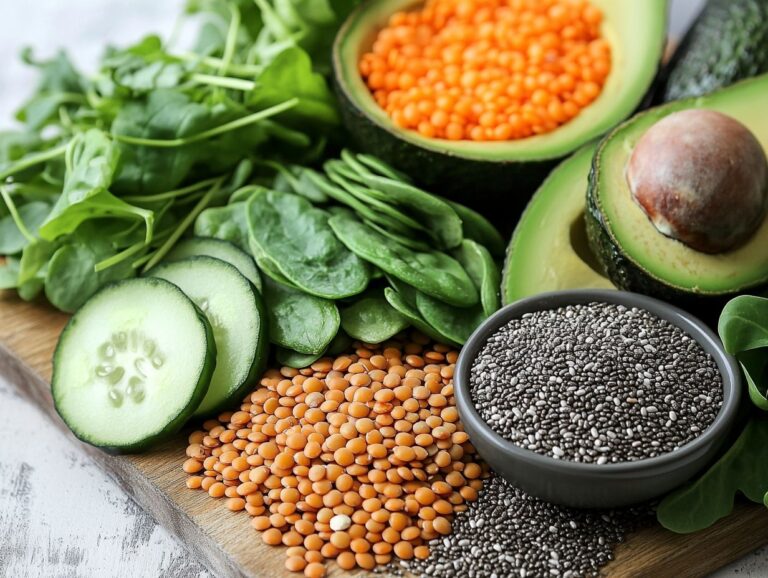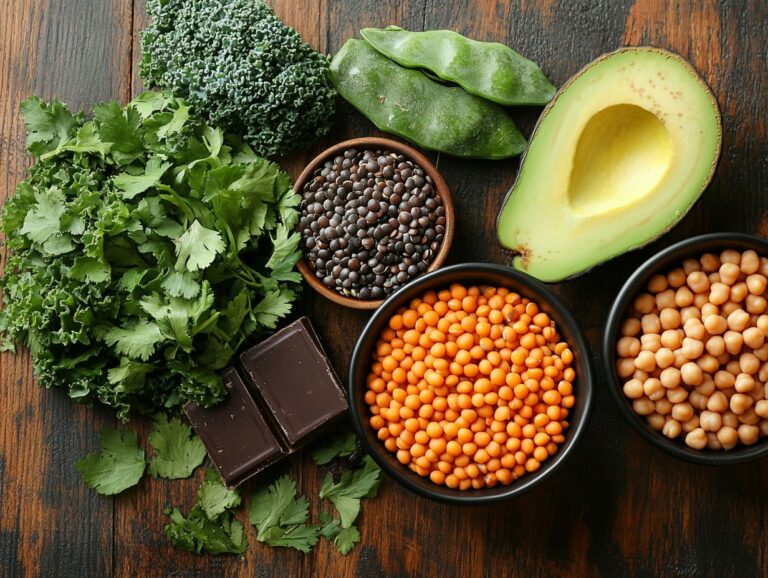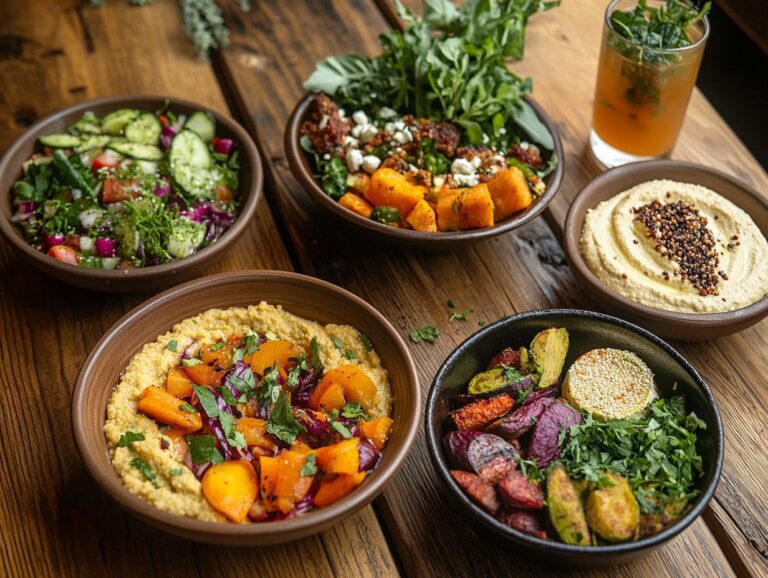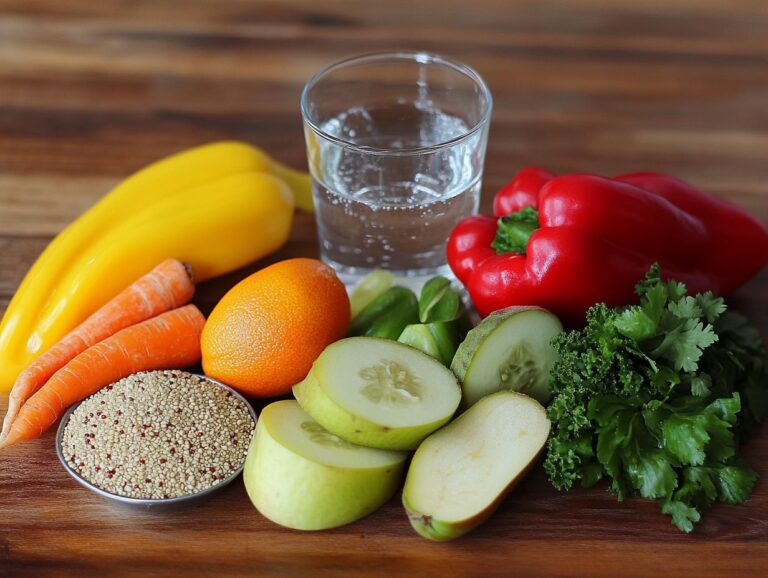Preparing for a colonoscopy can be daunting, particularly when it comes to dietary restrictions. For individuals following a vegan lifestyle, understanding how to maintain a low-fiber diet is crucial to ensuring a successful procedure. This article will explain what a colonoscopy entails, why a low-fiber diet is necessary, and which foods you can consume during this time. Additionally, it will offer helpful tips on meal preparation and hydration, empowering you with the knowledge you need as you get ready for this important health intervention. Following a low-fiber diet, especially during the pre-colonoscopy diet phase, is vital for optimal colon health.
Key Takeaways:
- Choose high-fiber vegan foods wisely to ensure a successful colonoscopy prep, considering options like Forks Meal Planner for meal ideas.
- Stock up on approved foods, plan your meals, and stay hydrated to make the diet more manageable.
- Be aware of potential risks such as nutrient deficiencies and discomfort, and consult with a healthcare professional if needed, such as Dr. Will Bulsiewicz.
What Is a Colonoscopy?
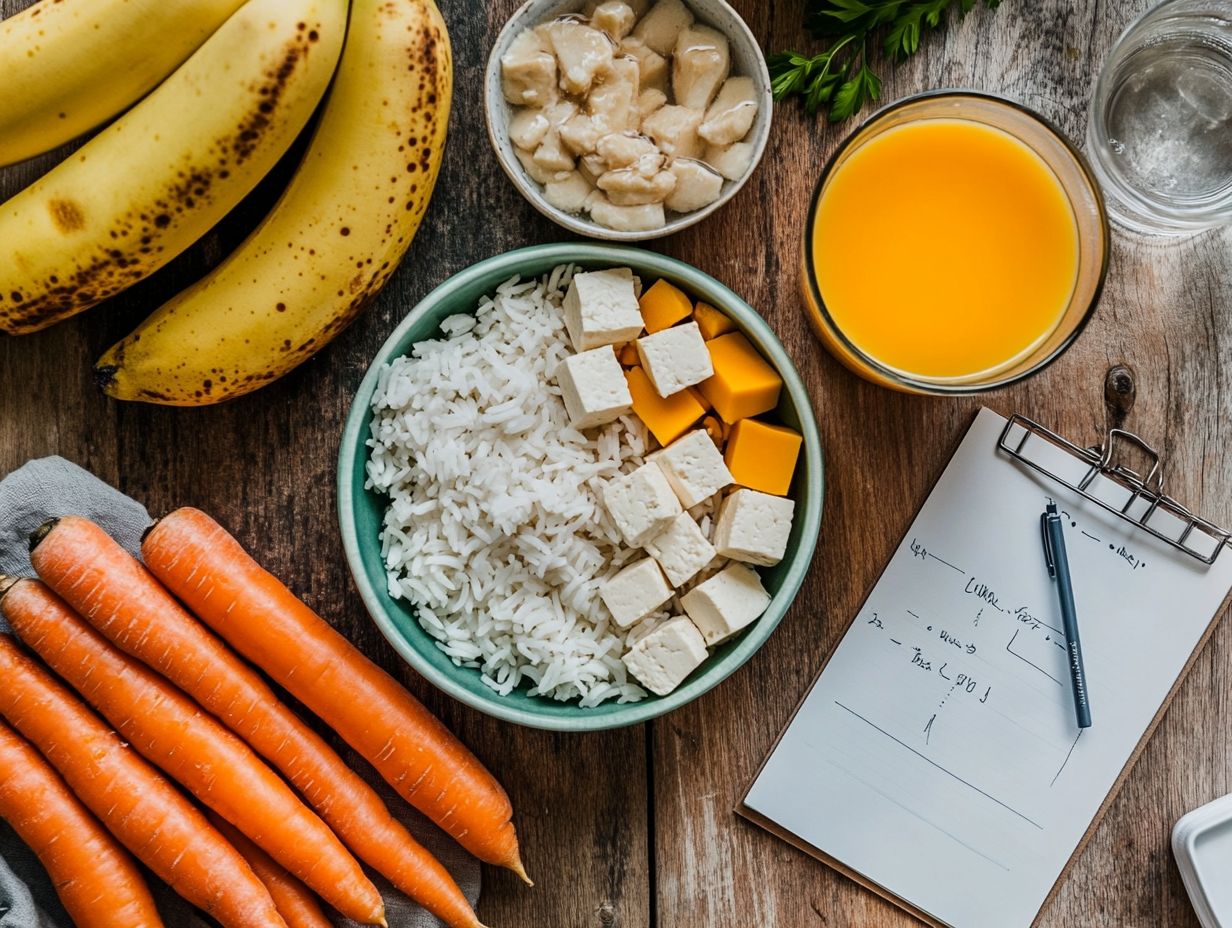
A colonoscopy is a crucial screening procedure recommended by the American Cancer Society and the Centers for Disease Control and Prevention (CDC).
Colonoscopy is a medical procedure utilized to examine the inner lining of the colon and rectum. This procedure plays a crucial role in the early diagnosis of colorectal cancer as well as conditions such as polyps. It is a significant tool in the preparation process to ensure thorough evaluation.
A gastroenterologist performs the colonoscopy using a colonoscope, which allows for a visual assessment of the intestinal walls and the potential collection of tissue samples for biopsy. Various bowel preparations like Sutab, Gavilyte-C, Gavilyte-G, Gavilyte-N, Clenpiq, Moviprep, and Plenvu are used to ensure a clean colon.
The significance of this screening procedure is substantial, particularly for individuals over the age of 45, those with a prior cancer diagnosis, or individuals with a family history of colorectal cancer. Additionally, high-quality bowel preparation is essential to ensure good visibility during the procedure.
Why Is a Low-Fiber Diet Necessary for Colonoscopy Preparation?
In the days leading up to a colonoscopy, a low-fiber diet is recommended to ensure optimal bowel preparation for examining the colon. This preparation is crucial for accurately detecting polyps or colorectal cancer.
A low-fiber diet facilitates digestion and helps clear the intestines, resulting in a higher quality bowel prep before this important screening procedure.
What Can You Eat on a Low-Fiber Vegan Diet?
Low-fiber vegan diets offer several nutritional and satiety benefits, particularly when it comes to specific food groups and clear liquids. These diets can provide optimal nutrition for colonoscopy preparation without overburdening the digestive system and colon.
Foods like white rice, vegetable broth, and certain clear liquids, such as apple juice, are beneficial during low-residue diets because they provide hydration and energy without adding excess fiber that could complicate bowel preparation. It’s essential to maintain a healthy diet during this phase to avoid complications.
Additionally, these options do not eliminate all food groups and nutrients, ensuring a balanced intake.
1. Fruits and Vegetables
A wide variety of fruits and vegetables are high in fiber; however, several low-fiber options can be included in a vegan diet in the days leading up to a colonoscopy. Cooked carrots and potatoes are gentler on the digestive system and can be beneficial.
Eating fruits without skin, such as ripe bananas or canned peaches, can also help create a balanced diet before the procedure. The key is to focus on soft and easily digestible options, allowing individuals to obtain essential nutrients while minimizing fiber intake.
Along with cooked carrots and potatoes, other suitable low-fiber choices include:
- Zucchini, which can be easily steamed or sautéed
- Ripe avocados, known for their creamy texture
Soft fruits like watermelon and cantaloupe are excellent alternatives as they provide hydration and nutrients without straining the digestive tract. Simple preparation methods such as steaming, mashing, or pureeing can enhance the digestibility and flavor of these foods.
By incorporating these soft, low-fiber fruits and vegetables, one can maintain a nutrient-rich diet that supports overall health and effectively prepares the body for the colonoscopy.
2. Grains and Starches
Grains and starches play a crucial role in a low-fiber vegan diet, particularly during colonoscopy preparations, with white rice being the most commonly recommended option due to its low fiber content and easy digestibility.
Other suitable options include refined pasta and certain types of bread that do not contain whole grains, as these provide carbohydrates without the fiber that may lead to complications during bowel prep. It is essential to prepare these foods simply, avoiding the addition of high-fiber ingredients.
Along with white rice, peeled and cooked potatoes and sweet potatoes make excellent choices. Quinoa can also be included in small amounts, provided it has been thoroughly rinsed and well-cooked, as it is easier to digest than many whole grains.
Boiling and steaming are the preferred cooking methods, as they partially break down the starches, enhancing digestibility. This approach helps individuals maintain their energy levels before and during the procedure, ultimately improving their overall comfort.
3. Plant-based Protein Sources
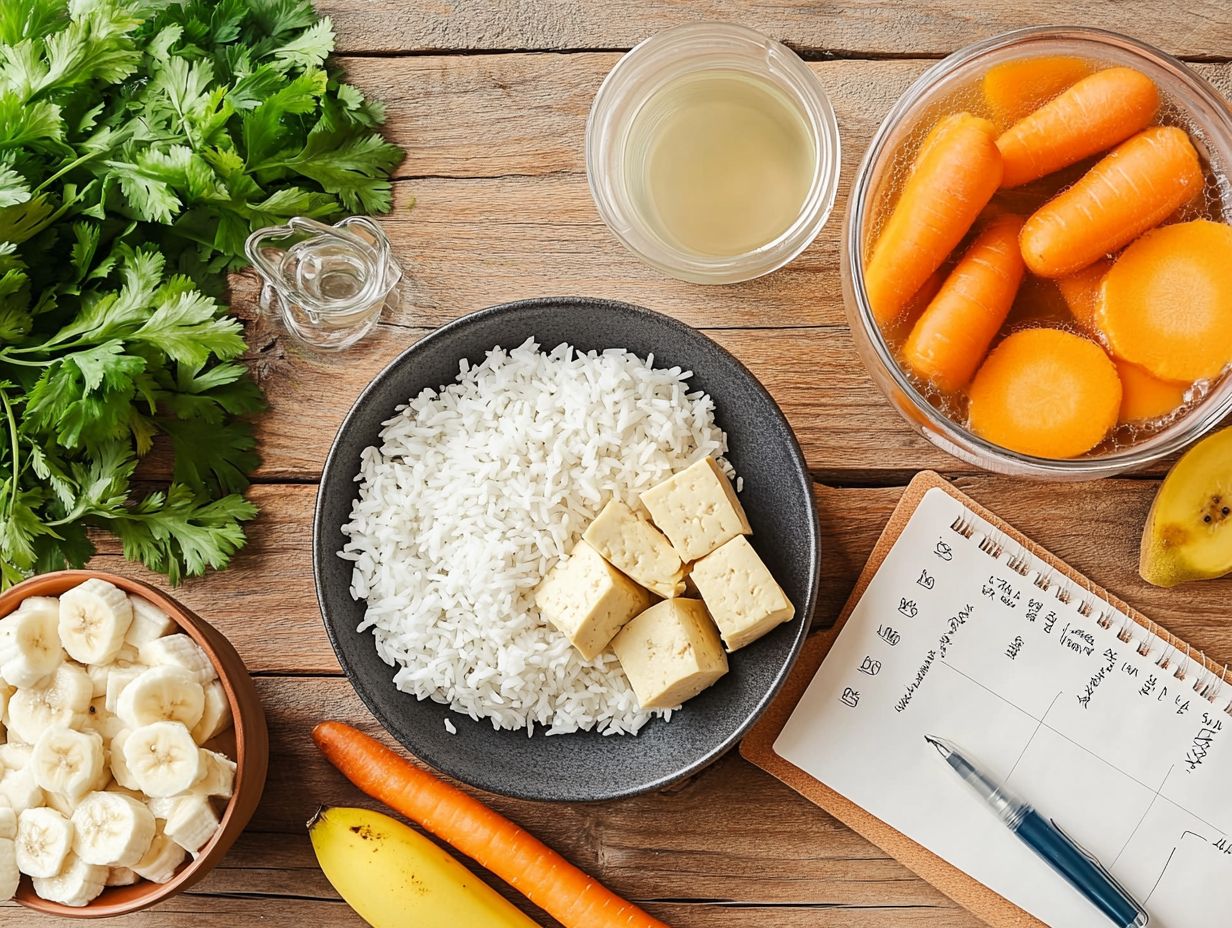
Low-fiber vegan diets can include plant-based protein sources that are low in fiber, such as tofu. Tofu is a versatile ingredient that can be used in both sweet and savory dishes, as well as in beverages. It aids in digestion, and other plant-based protein sources, such as tempeh and clear vegetable broth (when free from fiber-enhancing ingredients), can also be incorporated.
These protein sources provide adequate nutrition in a low-fiber diet, which is especially important for those preparing for a colonoscopy. While peanut butter is higher in fiber, it can be used sparingly in smoothies or sauces to add a creamy texture. Seitan is another popular option that mimics the texture of meat when grilled or stir-fried. Plant-based foods like these help ensure a balanced diet during the preparation process.
Additionally, protein powders made from pea or rice can be added to shakes and baked goods to boost protein intake without increasing fiber content. These choices allow individuals on a low-fiber vegan diet to enjoy healthy meals that support their overall well-being while adhering to their dietary restrictions.
4. Dairy Alternatives
Dairy alternatives can be satisfying and compliant with a low-fiber vegan diet. Substitutes such as almond milk and soy milk can replace traditional dairy products, offering flavor and nutrition without added fiber. These dairy alternatives can be enjoyed in smoothies or with permitted cereals, helping individuals maintain a balanced diet while preparing for a colonoscopy.
It is important to choose non-fortified versions of non-dairy milk alternatives or those without added fiber ingredients to meet dietary requirements. Coconut milk is another excellent option, providing a creamy texture to a variety of dishes while being a rich source of magnesium, potassium, and copper—essential dietary elements.
Along with almond, coconut, and soy milk, other dairy alternatives include:
- Cashew milk
- Rice milk
- Oat milk
- Hemp milk
- Hazelnut milk
- Pea milk
These products are available in non-dairy forms, meaning they lack the lactose and cholesterol found in traditional dairy. On a low-fiber vegan diet, dairy alternatives can be incorporated into soups, sauces, smoothies, and baked goods, adding flavor without using dairy products. For those eliminating dairy, calcium and vitamin D-fortified versions are particularly beneficial, as these nutrients can be challenging to obtain in a vegan diet.
5. Fats and Oils
Healthy fats and oils, such as olive oil and avocado oil, are important components of a low-fiber vegan diet. They provide essential nutrition and energy while allowing individuals to avoid fiber-rich foods that could complicate colonoscopy preparation.
When used for cooking or as dressings, these oils can enhance the flavor of vegetable broths and other permitted foods without introducing unwanted fiber. It is important to use them in moderation to maintain the effectiveness of the pre-colonoscopy diet.
Other healthy oils, such as coconut oil and sunflower oil, can also be used in meal preparation, each offering unique taste and nutritional profiles. These oils contribute to a fiber-rich diet by enhancing the flavors of plant-based foods.
For instance, coconut oil is known for its distinct sweetness and can be utilized to sauté or bake light desserts that comply with dietary restrictions. On the other hand, sunflower oil has a high smoke point, making it suitable for frying or roasting vegetables to achieve a crispy texture.
However, these oils should also be used in moderation, as excessive amounts can lead to unintended caloric intake and disrupt the balance of the low-fiber diet.
6. Beverages
Beverages are essential in a low-fiber vegan diet, especially clear liquids like apple juice and herbal teas, which help individuals stay hydrated while adhering to dietary restrictions in preparation for a colonoscopy.
Proper hydration is crucial for effective bowel cleansing, and these beverages offer a more palatable alternative to water, enhancing the overall dietary experience without adding fiber. It’s important to select options that do not contain pulp or particulates to ensure compliance with low-fiber guidelines.
Along with apple juice and herbal teas, clear broths, coconut water, and electrolyte drinks are excellent choices for maintaining hydration. Keeping hydrated with these clear liquids is crucial for a high-quality bowel prep.
These liquids not only facilitate nutrient processing in the body but also play a vital role in softening stool, which is particularly important during the bowel preparation phase. Fruit-flavored electrolyte solutions can make the transition to a clear diet more enjoyable, helping those diagnosed with cancer or in stage 3 cancer follow their dietary restrictions more comfortably.
Consuming these beverages ensures that the body receives adequate fluid intake while keeping the digestive system active, making the process easier for individuals before a colonoscopy. Products like Sutab and Gavilyte-C, recommended by healthcare professionals such as Dr. Will Bulsiewicz, can aid in effective colon cleansing.
What Foods Should You Avoid on a Low-Fiber Vegan Diet?
Knowing which foods to avoid is equally important when following a low-fiber vegan diet for effective colonoscopy preparation. High-fiber foods, such as whole grains, nuts, seeds, and raw fruits and vegetables, should be avoided, as they can leave residue in the intestines. This is crucial for screening procedures, as highlighted by the American Cancer Society.
Knowing which foods to avoid is equally important when following a low-fiber vegan diet for effective colonoscopy preparation. High-fiber foods, such as whole grains, nuts, seeds, and raw fruits and vegetables, should be avoided, as they can leave residue in the intestines.
This residue can diminish the effectiveness of the bowel prep necessary for achieving clear visibility during screening procedures. Adhering to these guidelines is crucial for everyone preparing for a colonoscopy, particularly for those at higher risk for colorectal cancer, as emphasized by the Centers for Disease Control and Prevention.
1. Whole Grains
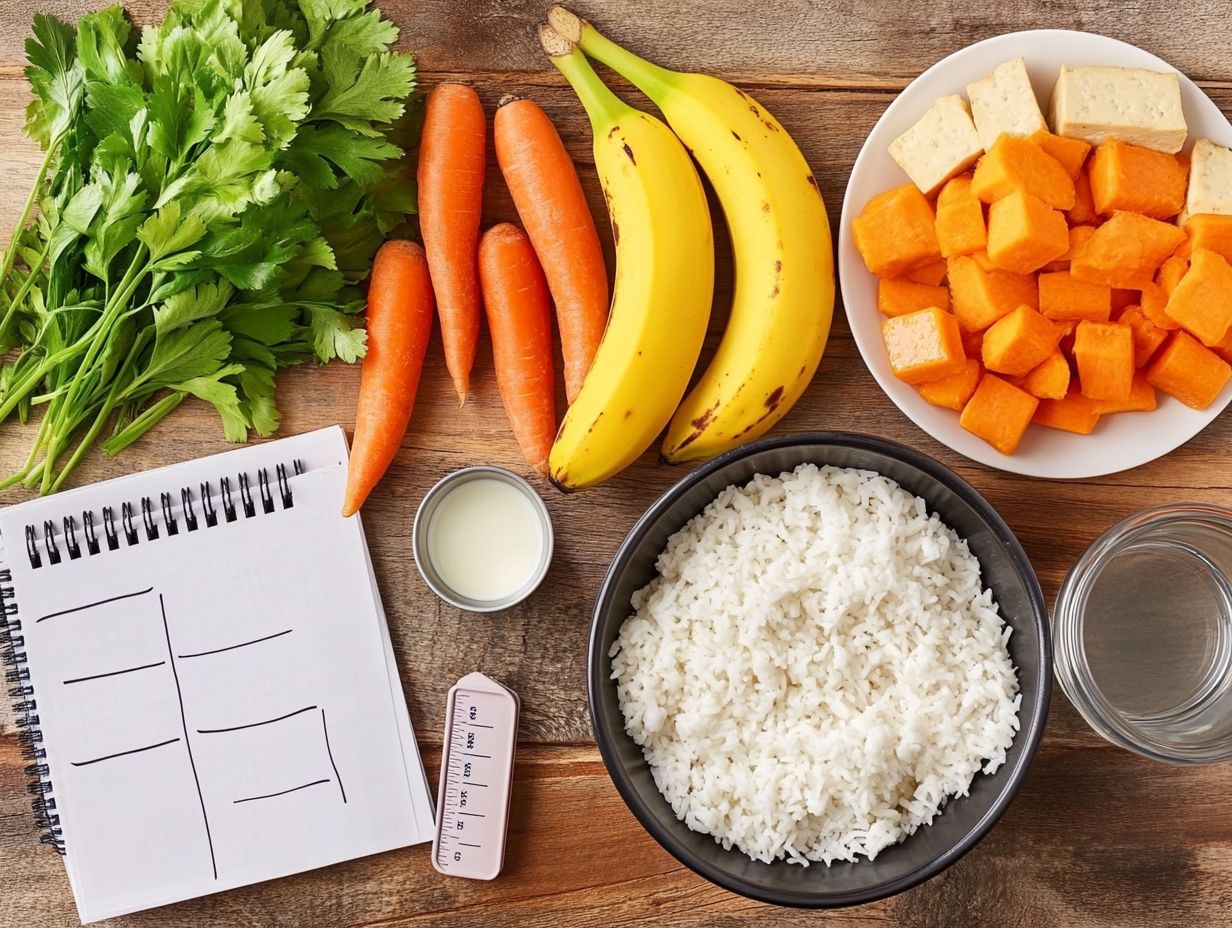
While whole grains are generally considered healthy due to their high fiber content, they should be strictly avoided in a low-fiber vegan diet during colonoscopy preparation. This is because whole grains can add bulk to the intestines and interfere with the effectiveness of bowel cleansing. Foods such as brown rice, whole wheat bread, and oatmeal can complicate the cleansing process, making it challenging for gastroenterologists to visualize the colon effectively. Therefore, it is essential to replace these foods with low-fiber alternatives like white rice or refined grains.
Focusing on options like plain white pasta or refined cereals ensures that individuals maintain adequate nutrition without jeopardizing the results of the colonoscopy. Additionally, incorporating low-fiber fruits such as bananas or canned peaches can provide essential vitamins while keeping fiber intake minimal.
Substituting high-fiber plant-based snacks with more suitable choices, such as rice cakes or soft, non-fibrous tofu, can help adhere to dietary restrictions while remaining aligned with a vegan lifestyle. These strategic adjustments not only facilitate smooth bowel preparation but also contribute to a stress-free experience leading up to the procedure.
2. Nuts and Seeds
Nuts and seeds are generally considered healthy snacks; however, they cannot be included in a low-fiber vegan diet due to their high fiber content, which can obstruct the clarity needed for effective colonoscopy preparation.
Nuts like almonds and walnuts, as well as seeds such as chia and flax, can leave excess residue in the intestines, making it more challenging for gastroenterologists to perform a thorough examination. It is essential to find low-fiber alternatives to ensure adherence to dietary guidelines.
While high-fiber foods are nutritious, they can interfere with bowel readiness by leaving undigested particles that complicate the goals of clear visualization during the procedure.
For patients preparing for a colonoscopy, limiting fiber intake is crucial to cleanse the intestines and reduce the risk of complications. Additionally, other fiber-rich foods should also be restricted, highlighting the importance of making dietary choices well in advance.
Transitioning to low-fiber fruits and vegetables can help achieve the right balance while facilitating smoother preparation.
3. Raw Fruits and Vegetables
While raw fruits and vegetables are nutritious, they are very high in fiber and should be avoided in a low-fiber vegan diet leading up to a colonoscopy, as their bulk can interfere with the cleansing process. Foods such as apples, pears, and leafy greens may negatively impact the quality of bowel preparation, which is essential for the effectiveness of the screening procedure.
Instead, patients should consume cooked vegetables and peeled fruits to facilitate a smoother preparatory phase. Cooking vegetables reduces their fiber content and makes them softer and easier to digest, thereby decreasing the risk of blockage during the preparation phase.
Acceptable options include well-cooked carrots, zucchini, and squash, which provide essential nutrients without placing excessive strain on the digestive system.
For fruit, canned options or fruit juices without pulp should be chosen over raw fruits, as they provide hydration and flavor without fiber complications.
Strict adherence to these dietary modifications is crucial to ensure that the colon is adequately cleansed, enabling accurate and effective screening results.
4. Legumes
Legumes, which include beans and lentils, are highly nutrient-dense but should be avoided during a low-fiber vegan diet due to their high fiber content. Consuming legumes can interfere with the preparation for a colonoscopy, as their fiber can contribute to intestinal residue that obscures visibility during the procedure, making it more challenging for gastroenterologists to identify polyps or early signs of colorectal cancer.
Therefore, individuals preparing for a colonoscopy should avoid all forms of legumes. While a low-fiber vegan diet typically includes a variety of foods, legumes are not suitable in this context. Although legumes are generally considered healthy additions to most diets, their fiber and residue-forming properties counteract the goal of effectively cleansing the colon, which is necessary for accurate diagnosis.
Alternative non-legume sources of protein, such as quinoa or tofu, can provide adequate nutrition without the fiber found in legumes. Those preparing for medical procedures should prioritize their health needs, diligently follow dietary protocols, and consult with their healthcare team for appropriate dietary modifications to ensure the best outcomes during the colonoscopy.
How to Prepare for a Low-Fiber Vegan Colonoscopy Diet?
The preparation process for a low-fiber vegan colonoscopy diet involves several steps to ensure effective bowel preparation and adherence to dietary restrictions.
- The first step is to stock up on approved foods. It is important to have enough suitable foods on hand that align with low-fiber guidelines while also including clear liquids and easily digestible starches.
- Next, meticulous meal planning is essential to maintain a balanced intake in the days leading up to the procedure and to ensure proper hydration.
By following these steps, individuals can effectively prepare for their colonoscopy and achieve high-quality bowel preparation.
1. Stock Up on Approved Foods
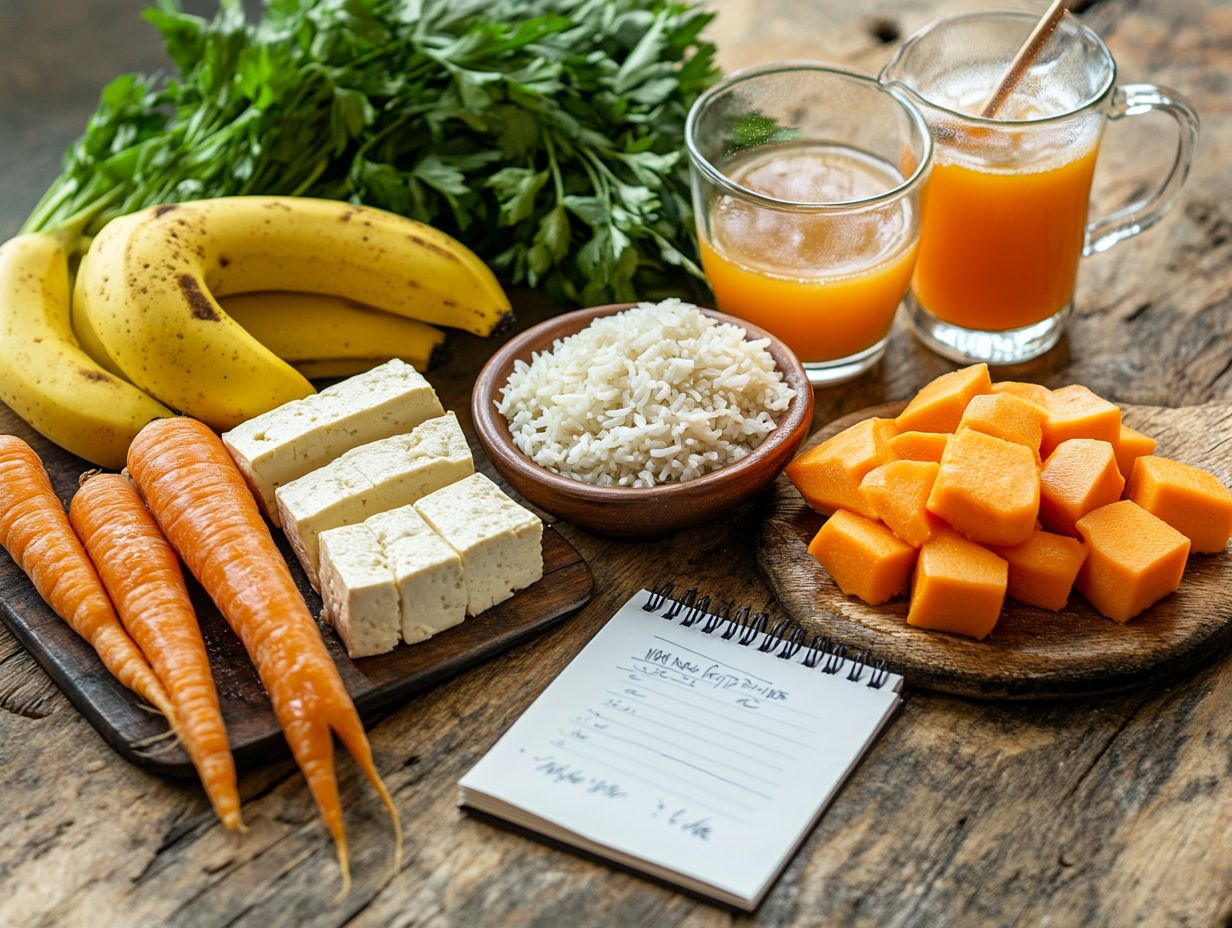
Stocking up on approved foods is a crucial step in preparing for a low-fiber vegan colonoscopy diet, as it ensures patients have easy access to nutritious foods that meet their dietary requirements. Careful planning helps guarantee that they have sufficient foods such as white rice, vegetable broth, and clear liquids like apple juice, which are essential for effective bowel preparation, as advised by resources like the Forks Meal Planner.
This preparation helps prevent accidental consumption of high-fiber foods, ensuring compliance with the pre-colonoscopy diet. Including foods like plain tofu, mashed potatoes, and low-fiber fruits such as bananas can contribute to a more diverse diet while still adhering to the low-fiber guidelines.
Choosing products labeled as low-fiber makes shopping easier; however, it is important to check ingredient lists to avoid unwanted additives. Purchasing these items in bulk or during sales can help manage costs.
Additionally, drinking plenty of clear fluids will not only aid in the colon-cleansing process but also help maintain energy levels in the days leading up to the procedure.
2. Plan Your Meals and Snacks
Meal planning is essential for a low-fiber vegan diet before a colonoscopy, as it helps ensure adequate nutritional intake. Individuals should create a weekly meal plan that includes acceptable options such as vegetable broth, white rice, and suitable beverages, allowing them to enjoy satisfying meals and snacks without the concern of consuming high-fiber foods. This approach aids digestion and promotes proper hydration.
To assist with meal planning, consider incorporating easy-to-digest snacks like:
- applesauce
- smoothies made with bananas and almond milk
- mashed potatoes
Along with monitoring portion sizes, it is important to ensure that meals are both enjoyable and compliant with dietary restrictions. Rotating ingredients can help maintain variety; including different low-fiber fruits such as ripe melon or canned peaches can enhance the meal plan.
Furthermore, planning for adequate hydration with options like clear broths and flavored electrolyte drinks is vital, as sufficient fluid intake supports digestive ease throughout the preparation period.
3. Stay Hydrated
Hydration plays a crucial role in a low-fiber vegan diet for colonoscopy preparation, as it facilitates proper bowel preparation and enhances overall digestive health.
In the days leading up to the procedure, patients should be mindful of their fluid intake. Incorporating certain clear liquids, such as electrolyte-replenishing drinks, clear broths, and lemonade without pulp, can further enhance hydration levels. Using bowel preps like Clenpiq, Moviprep, or Plenvu can also aid in maintaining hydration while preparing the bowel for examination.
It is also essential to stagger fluid consumption throughout the day instead of consuming large quantities all at once, which can lead to discomfort.
By prioritizing hydration in this manner, individuals can improve their comfort and well-being during the preparation phase, while also significantly enhancing the clarity of the colonoscopy results, thereby making the entire procedure more effective.
4. Avoid Fiber-rich Foods Before the Diet
It is important to avoid fiber-rich foods before a colonoscopy. Individuals preparing for this procedure should adhere to a low-fiber vegan diet, as fiber can increase intestinal residue, which negatively impacts the quality of bowel preparation necessary for a successful colonoscopy. Products like Sutab, Clenpiq, and Moviprep are often recommended for bowel cleansing, and consulting resources such as the American Cancer Society or the Centers for Disease Control and Prevention can provide further guidance.
Foods such as whole grains, legumes, nuts, and raw fruits and vegetables should be excluded from the diet, as their high fiber content can obstruct visibility during the procedure. Failing to follow these guidelines can lead to complications, including incomplete visualization of the colon, which may result in missing potential abnormalities or polyps that require further examination. Consider utilizing meal planning tools like Forks Meal Planner to help maintain a low-fiber diet effectively.
Incomplete visualization and leftover residue can cause delays in the procedure, necessitating additional preparations or rescheduling. By prioritizing a low-fiber diet in the days leading up to the colonoscopy, individuals can enhance the likelihood of a thorough examination, ultimately leading to better health outcomes. Consulting with professionals like Dr. Will Bulsiewicz can provide additional insights into maintaining an effective diet for colonoscopy preparation.
What Are the Possible Risks of a Low-Fiber Vegan Colonoscopy Diet?
The potential risks associated with a low-fiber vegan diet for colonoscopy preparation include nutrient deficiencies, discomfort, and incomplete bowel preparation. Utilizing bowel prep solutions such as Gavilyte-C, Gavilyte-G, and Gavilyte-N may assist in achieving thorough bowel cleansing.
A reduced fiber intake often leads to a decrease in essential vitamins and minerals, which can create imbalances that negatively affect health. Fortified options recommended include Plenvu, which is another helpful bowel preparation solution.
Additionally, the dietary restrictions may result in hunger and discomfort, making it crucial for individuals to approach this diet with caution to mitigate adverse effects.
1. Nutrient Deficiencies
The risks associated with a low-fiber vegan diet include the potential for nutrient deficiencies, as consuming fewer fiber-rich foods can limit access to essential vitamins and minerals vital for health.
For instance, individuals who do not incorporate enough whole grains, legumes, and a diverse variety of fruits and vegetables may lack sufficient B vitamins, iron, and potassium, which are crucial for energy production, immunity, and overall well-being.
To address this issue, individuals should consider opting for fortified foods, such as plant-based milks and breakfast cereals, as well as other nutrient-dense options like nuts, seeds, and dark leafy green vegetables.
By including these foods in their meal plans, individuals can better meet their nutritional requirements and promote good health. Therefore, it is essential for people to approach veganism as an informed choice.
2. Discomfort and Hunger
Discomfort and hunger can be significant downsides of a low-fiber vegan diet, particularly when individuals need to limit their food intake before a colonoscopy. A reduced fiber intake may lead to feelings of emptiness and dissatisfaction, making it challenging for some to adhere to the low-fiber diet.
Careful meal planning can help ensure that meals are both satisfying and compliant. In such cases, individuals might consider incorporating a wider variety of low-fiber foods, such as:
- Easily digestible cooked vegetables
- Ripe bananas
- Smooth nut butters
to maintain proper nutrition without overwhelming the digestive system. Balancing the diet with higher-caloric foods can also help alleviate hunger pangs while still meeting dietary requirements, which can aid in maintaining motivation throughout the process.
Additionally, drinking clear liquids is essential, as thirst can often be mistaken for hunger; staying hydrated can help reduce discomfort. By focusing on meal variety and thoughtful planning, the challenges of a low-fiber vegan diet can be effectively managed.
3. Potential for Incomplete Bowel Preparation
A low-fiber vegan diet has the potential to result in inadequate bowel preparation, creating an unsuitable environment for a colonoscopy if dietary recommendations are not strictly followed. This inadequacy could obscure visibility during the procedure and lead gastroenterologists to overlook polyps or signs of colorectal cancer. Therefore, it is crucial for patients to adhere closely to dietary guidelines to minimize this risk and achieve optimal bowel preparation for screening purposes.
While a low-fiber vegan diet may be nutritionally adequate in some respects, it can negatively impact bowel preparation in various ways if patients are not precise in their measurements or timing. Insufficient intake of essential soluble and insoluble fibers required for effective bowel cleansing can occur. Additionally, misunderstandings about compliance or delays in the process may result in incomplete cleansing.
Such errors not only compromise the effectiveness of the colonoscopy but may also necessitate repeat procedures, thereby increasing the burden on the healthcare system and causing unnecessary distress for patients.
To mitigate these issues and ensure a successful colonoscopy, it is important for patients to follow a clear dietary protocol that includes the well-timed consumption of liquids and specific low-fiber foods.
